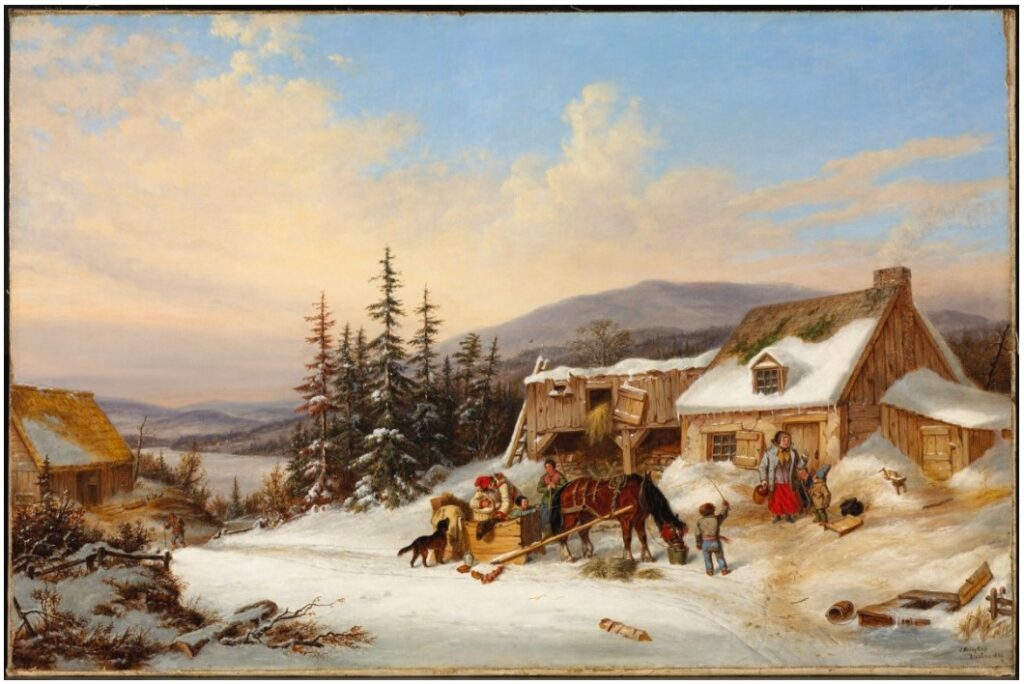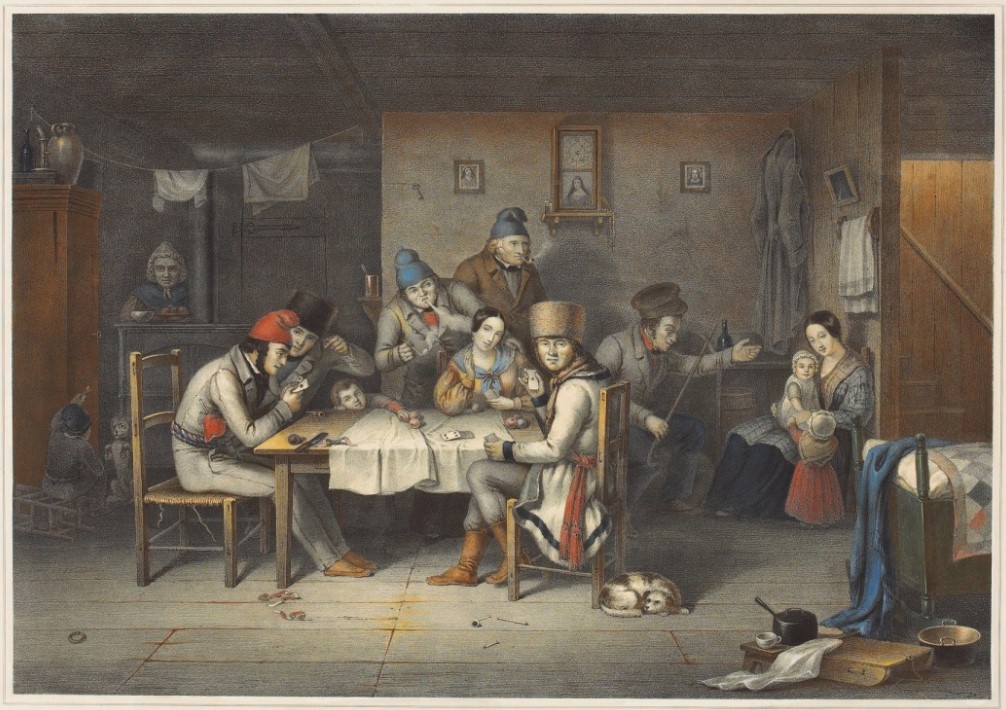This follows the earlier excerpt of letters published in the Windsor-based Vermont Journal concerning rural life in Lower Canada. See Part I here. This post is based on letters published June 23 and July 21, 1860.
* * *
The grain-harvest treads close upon the heels of haying. It is astonishing how rapidly vegetation advances in this latitude. Wheat sown at this season of the year is ready for the reaper by the middle of September; corn becomes accustomed to growing to maturity in a very short time; and when taken south, hurries, as it were, for the first year or two to ripen in an equally short space of time, not knowing that it has been transplanted from its native clime.—Shortly it learns to loiter by the way and in three or four years’ time it occupies many more days in coming to maturity, than it did here.
All hands help gather in the grain as well as the hay. The grain is mostly cut with the sickle.[1] The father, mother, brothers and sisters reap together through the long autumn days, as they while away the wearisome hours in smoking, badinage [friendly banter] and song. How many demoiselles think you there are in all yankee-dom who would or could go into the fields and reap? Very few, I think; but it would impart new life into their systems if they would do some such thing; they would soon possess lungs capable of containing more than one pint of air at an inhalation—their children would feel the new impulse of life imparted to them—and consumption [tuberculosis] would pass by thousands on whom he now fastens his skeleton fingers. The Canadians count their harvests by bundles, which are very large—three or four of them yielding a bushel—and always bound by a withe. One dollar an arpent (a little more than an acre) is the price usually paid for reaping and binding. A more pleasing sight cannot be imagined than is presented of an afternoon in harvest-time—hundreds of teams can be seen in all directions, loading, laden, and going to load with the golden produce of the fields. I can never behold it without thinking of those enchanting scenes described in the Georgics of Virgil, centuries ago, in sunny Italy; once happy, now how miserable!
But let us look about the house a little. The garden attracts your attention. Plum and cherry-trees surround it. It is neatly and tastefully laid out—containing great quantities of onions, cabbage, &c.; and is ornamented with flowers of various kinds. The interior of the house is always neat; they never wash their floors with a mop—do not know what such a thing is—but always scrub it with a stiff brush and a cloth, down on their knees and one hand. The same articles of furniture, made just in the same way, and arranged in the same manner are in every Canadian house. They eat much fat pork, but the climate admits of it without injury to the health. Soup is regularly served once a day; pies they hardly know how to make—warm cakes they seldom eat—bread, wheat bread, may truly be said to be the staff of life with them. They make great quantities at a time—enough to last a week or more—in the out-door ovens I have pointed out to you before. The loaves are always of one size and of just such a form, baked on the bottom of the oven.

The blood of all animals slaughtered for use is carefully saved and used for food. When a sheep, a hog or a turkey is to be butchered you will see the good woman standing by, with her sleeves rolled up and a pail to catch the blood. It is cooked in various ways. They never scald a hog to get the bristles off, but pile a lot of straw upon him and burn them off. Those who have seen scalded pork prefer that which has been burned; and the butchers in the city actually have to keep that which has been burned to supply some of their customers. Altogether their mode of living is more healthy than that of the New Englanders.
The Canadian has very few taxes to pay in comparison with the people of any other country on earth. He has a small school tax, a less road tax and a still less municipal tax to pay; the [f]eudal laws are almost or quite abolished—there are no more lods et ventes or commutation fines to pay—the rights of banalité are done away with, and the farmer has nothing to complain of.[2] A property which in Vermont would be taxed, say fifty dollars, would not have to pay five here. This would make a great difference in a few years. It may not occur to all of your readers how this state of things can exist; but it must be borne in mind that we have but one government here—no double gear about it—and that is supported by excise, customs, the sale of public lands, &c., while with you the general government swallow these all down, and leave each state to provide for its own expenses.—This is one great objection to a federation of states here.
Almost every range in the French country has its mechanics of all kinds—the shoemaker and blacksmith, cooper and cart-maker, tailoress and tinker are convenient to all. Much time is thus saved to the farmer in getting his needed repairs; and he can often pay the mechanic in farm produce. These shops serve as a kind of rendezvous where those who have an idle hour assemble. Here some of them pass the long winter evenings and the rainy summer days, while the news and the scandal of the range are discussed. […]

Nothing, perhaps, shows more clearly the natural disposition of the Canadian to take the world easily than the general practice of giving out their farms on a life-rent. No sooner has he acquired a property whose yearly produce is sufficient to support him, than he gives it out to some of his relations, and retires from active life, to pass the remainder of his days in undisturbed repose.[3] A great proportion of the villages is composed of such persons who are living on the yearly rents they receive. Here from morning till night, from January to January, he smokes his pipe and tells stories, tells stories and smokes his pipe. How different from the [Y]ankee! [H]e sticks to all he has acquired, is always desirous for more, and hangs to his wealth until he is torn from it by death. Unless his life is simply a life of toil and vexation, the Canadian acts the more rational part.
On Friday evening the labors of the week may be said to close in our habitant’s dwelling. Saturday is the regular market day, and thousands flock to the market-towns on those days. You will recollect that I gave you an account of these markets in a former number. They carry all kinds of farm produce and find a ready sale for it. There the farmer changes his wheat, barley and oats, eggs, poultry and pork, the produce of the garden and the manufacture of his house, for money. The schools are all closed on Saturday, and in the afternoon their dwellings are all neatly scrubbed out, the door-yard is swept of every stick and straw, and all things are made ready for the day of rest. The sun rises Sunday morning bright and clear,—the air is fresh and invigorating—the sweet odor of flowers and the songs of birds are borne on the passing breeze—the bells, “morning bells,” call the inhabitants out to Mass.
The Canadians are well prepared for winter, and there is not half the suffering amongst them and with their cattle as there is in the West and other countries where there is not near so much cold as here. Their houses are small and well plastered up; a large double stove keeps the whole house warm from November to April,[4] their stables are plastered with clay, and water will hardly freeze in them through the winter; they dress warmly, from the oldest to the youngest, wearing flannel next to them, and their other garments consisting of flannel or heavy fulled-cloth. You may see, on the stormiest, coldest days that blow, little Canadians, not more than two feet long, digging through the great snow-drifts, not thinking that it is cold. They have little to do through the winter but to thresh their grain, draw their fencing-stuff, and get their wood. The first is done with a threshing-machine and takes but a few days; the getting of their rails and wood is a more serious affair. I know of farmers of whole ranges who have to draw both from seven to twenty miles; but they make a holly time even of this.
[1] The scythe was likely more suited to the hay harvest, lest there be any waste. The sickle enabled harvesters to create smaller bundles that would take less space in grain lofts. In Europe, this practice also had the advantage of leaving stalks that could be used for thatching.
[2] The seigneurial system was formally abolished in the 1850s, though the seigneurs and their families continued to receive public compensation for generations after.
[3] We have previously seen this practice in the story of Guillaume and Julie Larocque.
[4] We cannot underestimate the significance of the introduction of cast-iron stoves, which enabled the habitants to take cooking away from the fireplace and heat their homes more effectively.
Pingback: This week's crème de la crème - November 4, 2023 - Genealogy à la carteGenealogy à la carte